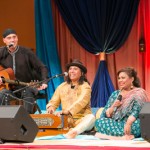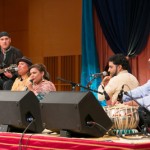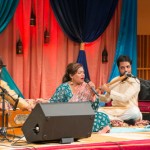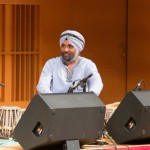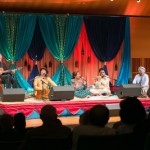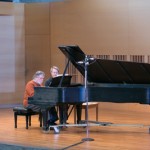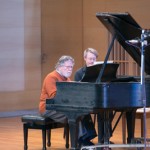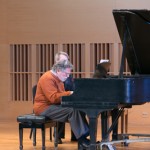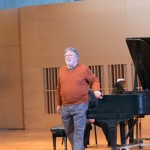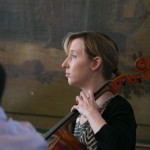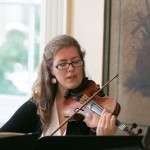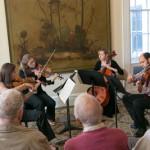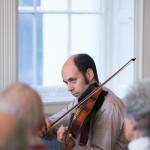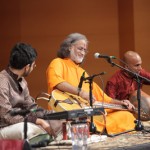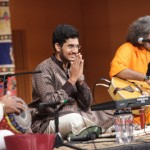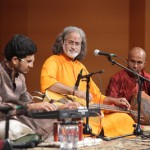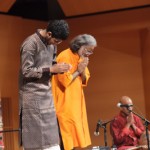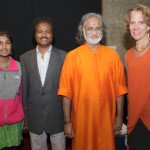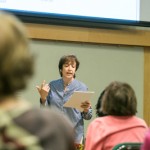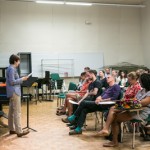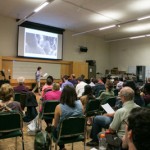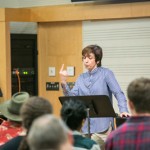CFA Arts Administration Intern Chloe Jones ’15 talks to Miranda Orbach ’15, Eriq Robinson ’15, and Virgil Taylor ’15 about their theses in Dance, Music, and Studio Art.
With the deadline for theses this Friday, April 10, 2015, Wesleyan seniors from all different majors are hunkering down across campus to complete the projects they have dedicated their year to. Thesis writers in Dance, Music, and Studio Art are presenting their work at the Center for the Arts every week through the end of the semester.

Featuring new works by eight choreographers, the Spring Senior Thesis Dance Concert took place last weekend in the Patricelli ’92 Theater. Closing the first half of the concert was Miranda Orbach’s form[all] training, a piece in partial fulfillment of her honors thesis in American Studies and Dance.
Ms. Orbach’s written thesis, “Monstrous Form: the Ballerina and the Freak,” draws the ballet and the freak show together to examine how each distinct performance mirrors the other. Her thesis reads the ballet through the lens of the freak show, and the freak show through the lens of the ballet.
“Historically we have separated these forms so far away from each other,” says Ms. Orbach. “Bringing them together actually allows us to intervene in the literature about both of them. It’s not that they are the same, but that they are useful for reading each other, as spectacle, body, and display are central themes to both performances.”
In her thesis, Ms. Orbach tells the story of one ballerina: Caroline Shadle ’16, who performs in the piece with two other female dancers. They dance with one foot in a pointe shoe and one barefoot to a sound score that narrates Ms. Shadle’s story, giving powerful insight into the life of an aspiring ballerina.
“The feeling of freakishness is not so far from the feeling of being trained,” says Ms. Orbach. “The two work in tandem. All of these categories that we oppose so starkly in society—form and deformity, ability and disability—are actually inherent to each other.”
Eriq Robinson’s senior recital, Reality Ends Here: The Beginning of the End, will take place this Thursday, April 9, 2015 at 7pm in Fayerweather Beckham Hall. The recital, featuring a vocal ensemble and a horn ensemble, is one component of Mr. Robinson’s thesis in Music. The vocal ensemble is inspired by South African overtone singing, the music of the Japanese Ainu, and Slavei, an a cappella group on campus that performs Slavic, Balkan, and Georgian liturgical music.
“The performance is a narrative story telling experience with music, based on a cosmological structure that I made up myself,” says Mr. Robinson. His cosmological structure is based on ideas from Buddhism and other Eastern religions, as well as Abrahamic religions and some African religions.
“It’s a story about the beginning of the end of the world,” he explains. “The idea is that humans are the nerve endings of the cosmos. We are all just the end of invisible tendrils that are the cosmos, all part of a giant macro organism.”
In the written component of his thesis, Mr. Robinson gives a short history of Afro-Futurism and attempts to determine if his music fits into that creative lineage.
“Because I’m making up a cosmological structure, I’ve been trying to make music that doesn’t sound familiar,” he says. “The hardest part about it has been trying to make music that sounds unfamiliar, while at the same time not making bad music. What I think makes music good, on an objective level, is having some sort of system and methodology that’s tying it all together.”
Mr. Robinson plans to continue writing his story even after the recital, and hopes this will be the first in a series of performances.
Studio Art major Virgil Taylor’s thesis, Irregular Quadrilateral, will be on display in the Ezra and Cecile Zilkha Gallery from Tuesday, April 14 through Sunday, April 19, 2015; with an opening reception on Wednesday, April 15, 2015 from 4pm to 6pm.
After receiving a Zawisa fellowship from the Wesleyan Studio Art Department last spring, Mr. Taylor travelled to Albuquerque, New Mexico in the summer to study metal plate lithography at the Tamarind Institute. The youngest person in the program, both of his roommates were university professors.
When Mr. Taylor returned to Wesleyan this past fall, he realized he wanted to shift the focus of his thesis from lithography to intaglio prints. Intaglio refers to a printmaking process in which the image is carved into the plate with acid, a scribe, or a needle.
“Even though I did not end up doing my thesis in lithography, I think my work at the Tamarind Institute this summer really informed me on how to think about compositions,” says Mr. Taylor. “It was an opportunity to spend four weeks doing nothing but printmaking.”
His exhibition will fill Zilkha Gallery with intaglio prints of irregular quadrilaterals, which look like rectangles in perspective. In addition, he has created a large-scale composition resembling his prints that will occupy the back bay of the gallery—a 24 foot long piece of steel painted blue will mirror the many blue lines in his prints, and an eight foot tall drywall panel will appear in the shape of one of his plates.
“I’m interested in work that doesn’t require or desire any explicit content, or really any implicit content, but exists as a formal space,” says Mr. Taylor. “That’s why I like being able to make the giant version, because I can emphasize that it’s simply an arrangement of forms.”




